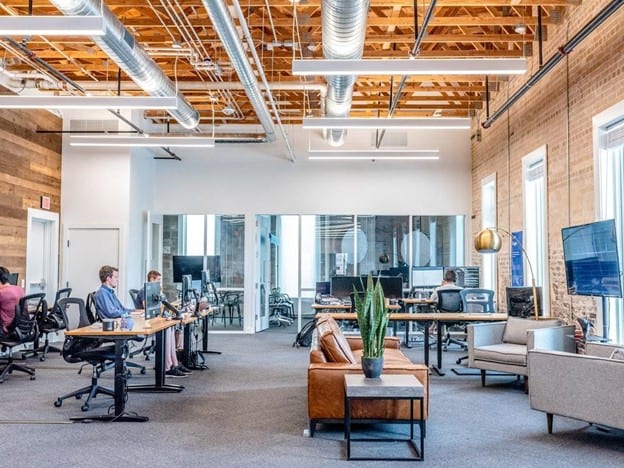Before 2020, remote working in any capacity was not a widespread occurrence. For most workers, it was rare or even not possible at all. But since then, there has been a paradigm shift regarding the standard office model. There was a realization across many industries that in fact many jobs could be done at home. The only real reason for so many jobs still taking place within an office environment was merely a continuation of the classic model. So now, we are experiencing a zeitgeist within the business industry by both managers and employees.
While a ubiquitous shift to fully remote work is not quite in the cards yet, a hybrid work model seems to be a very popular solution to address the desire of both employees that wish to work remotely and managers that still wish to have a physical presence in the office. Since the hybrid model is still in its relative infancy, organizations will still have to experience some growing pains. This is because there is not a single hybrid model that can be implemented across the board when switching to a hybrid work model. Each organization will have to grapple with the advantages and disadvantages of the hybrid work model and figure out how it can work best for them.

What is a Hybrid Work Model?
A hybrid work model is exactly as it sounds. In its most basic form, it’s a hybrid of in-person and remote working. Meaning that some employees work in the office and some employees work remotely. Sometimes it’s specific teams that are given the chance to work remotely, or it’s whoever wishes to take up the opportunity to do so. It all depends on how the manager wishes to deploy the model.
The Different Types of Hybrid Work Models
There are many different ways in which a manager can deploy a hybrid work model that is dictated at an individual level, or at a team/department level. This can vary significantly for each organization, however. A more inclusive delineation of the types of hybrid work models that are not as organization-dependent is differentiated by the amount of time spent in the office. These are (in order from most remote to least remote) remote first, office occasional, and office first – remote allowed.
Remote First
The remote-first hybrid work model most closely mirrors an organization that’s gone fully remote. However, there are some exceptions. Some level of office space would continue to exist for employees to use. So, for some employees that prefer working full-time in the office, they can continue to do so. However, the difference is at the organizational level. As the organization, and most likely a large portion of the managerial staff will focus on remote work. Some notable companies that have successfully implemented a remote-first model are Coinbase and Dropbox. Dropbox’s offices now resemble more of a coworking space rather than an office.
Office Occasional
The office occasional model pretty much is the implementation of organization-wide flex scheduling. Meaning that employees should still come into the office a couple of times per week. This could be because the company is not quite ready for a more remote-oriented model or perhaps they believe that the culture and outcomes are better when there is some level of in-person collaboration and interaction. This model finds itself straddling both the remote-first model and the office-first model and can easily get pulled in one direction or the other if it isn’t clearly defined through organizational guidelines.
Office First/Remote Allowed
And the model that most closely resembles the classic in-person model is the office-first model that allows for the occasional remote working experience. The exact implementation of this can vary as it may have some team members or a department working remotely while the bulk of the company is office-centered – often including the office leadership.
So, some employees may be scattered or working remotely, either full-time or only a part of the time while most of the employees are in the office. Or it could be that almost any employee – depending on the job requirements – can take the occasional day to work remotely. This sort of system was the most common before 2020. But it can be the most susceptible to the pitfalls of the hybrid model as it doesn’t commit to addressing them as much as the two aforementioned models that put a higher priority on remote working.

Advantages and Disadvantages of a Hybrid Work Model
There isn’t such a thing as a single perfect work model. An organization can simply do the best it can to implement a model that can support the desired company culture while achieving the primary business goals. They should understand the advantages and disadvantages of a hybrid work model so they can successfully employ a strategy that fits their goals and culture.
Advantages
The reasons for implementing a hybrid model are obvious. It can make for a more dynamic and motivated workforce while cultivating positive company culture. It can also help to save costs and greatly increase the hiring pool.
Increased Hiring Pool
It’s no surprise that when you allow for a more remote-oriented organization you are no longer stuck hiring from within the confines of your geographic location or depend on a new hire relocating. When you’re able to break free from the proximity restriction you can access a much greater pool of skilled talent, nationwide or even globally.
Increased Productivity
When you work fully in an office you could be spending a lot of time doing low-value activities like trying to focus in a crowded office, talking to coworkers, or a long commute. While Talking with coworkers has a positive side like building bonds and relationships, losing focus and commuting doesn’t offer any upside. By removing these activities that offer little to no added value you can spend time effectively giving yourself more free time.
Studies have also backed this up. A Gallup poll found that employees that work remotely at least part-time had the highest levels of engagement. However, those that worked fully from home suffered from the highest levels of burnout. This supports the implementation of hybrid systems and perhaps isn’t surprising because it gives employees more flexibility in doing what works for them.

Better Accommodate Employees with Disabilities
As outlined in the Americans with Disabilities Act, companies are supposed to provide “reasonable accommodations” for those that have chronic illness or disabilities, oftentimes employers find those accommodations to be unreasonable. This is particularly true for in-person jobs. Since a hybrid work model is more flexible by nature, it can easier facilitate those with disabilities.
Lower Overhead
The size of the reduced overhead costs depends on how a firm implements the model. If a company keeps its full-size office for whatever reason (lease agreements, providing a familiar space, etc.) then the reduction in overhead can be minimal. This can likely be the case of a firm that is transitioning from a traditional work model to a hybrid model. But if an organization is in its infancy it’s much easier to implement a hybrid system and create an office space accordingly. By fully leveraging a hybrid model you can save greatly on your overhead. You can rent a smaller office space that doesn’t need to accommodate the entire employee roster at all times. Instead, you can plan to use a more “a la carte” methodology and only pay for the minimum for what your office needs.
Decreased Health Risks (illness and burnout)
Before 2020 it’s pretty amazing to think that it was pretty common to go to work sick. 90% of workers have admitted to working while sick. It was common during cold and flu season to hear an orchestra of sniffles, coughs, and sneezes throughout the office. This obviously isn’t healthy and is actually quite concerning. The hybrid work model can improve this by reducing the necessity for so many to work in the same place. Additionally, even though people should focus on resting and not working while they are sick, if they are still inclined to work, they can do some from home. Thus, reducing the likelihood of a virus spreading through the employees.
A hybrid work model can also address the increased burnout that occurs when one works entirely in-person, or remotely. This is because it can alleviate the pressures that occur from either end of the spectrum. When you are working completely remotely, employers may expect you to be “always-on” and therefore it may degrade your home experience. On the other end of the spectrum, the office work culture has been causing burnout long before burnout from working from home was even possible. A hybrid model seeks to find a happy middle between the two.

Disadvantages
The various hybrid work models aren’t without their flaws, though. There are a few problems that can arise when a hybrid work model is deployed. However, if a model is implemented correctly the issues can be greatly minimized or not be a problem at all.
Isolation
The more an organization is fully remote on the spectrum of fully in-person to fully remote, the more likely it is that employees will feel isolated. And this is no surprise. A key component of the office culture is face-to-face communication, even if it’s just brief hellos or small talk. And when the team is decentralized, this is the hardest component to replicate. Those that are hit the hardest are likely to be the more extroverted individuals that need more interpersonal communication. Those that are more introverted are less likely to feel such isolation. However, when an organization implements a hybrid model it can still allow for in-person collaboration or social gatherings which can help to build cohesion and reduce the feeling of isolation.
Time Zone Challenges
An unfortunate consequence of hiring employees from a pool of global talent can be the resulting discrepancies in time zones. Depending on the organization, this can be very challenging. If it’s a large organization with hubs around the world, it’s less of a problem. But for small to mid-sized decentralized organizations, this can be a bigger hurdle. Scheduling meetings when the team is scattered around the world can be very inconvenient for managers and team members. It may result in certain team members having to attend meetings at unconventional times, or not attend the meeting. This can have negative consequences particularly when it comes to isolation and the feeling of inclusion in the team or organization.

Requires Practice in Communication
For a digital native, it may not as be as difficult to heavily rely on digital communication. However, for managers and employees that have had to adapt later, it can be more difficult. Particularly if an organization is moving from a traditional office environment to a hybrid model. It requires finesse and practice to successfully communicate in a digital manner when an organization is decentralized.
Discrepancies in Treatment – In-Person vs Remote
Lastly, and perhaps the biggest drawback in terms of career advancement is the discrepancies in treatment for those working in-person and those working fully remotely. It’s generally understood that those that spend more time cultivating relationships face-to-face are more likely to have better chances in advancement compared to those that are seldomly, or never in the office. Which makes sense. As mentioned before, the more remote an organization, the more difficult it can be to forge relationships. And if there are some people that work in-person with a manager or team leader, they are more likely to reap the benefits of the deeper relationship.

How to Make the Hybrid Work Model Work for You
Ultimately, how an organization implements or switches to a hybrid work model can determine how successful it will be. While it’s most advantageous to implement a hybrid work model it needs to be done in a manner that suits the goals and culture of the organization. This means that the organization needs to effectively plan how it will implement a hybrid work model. Particular attention needs to be paid to the negative aspects of remote working and should be addressed during the planning process.












